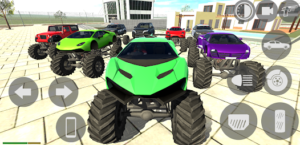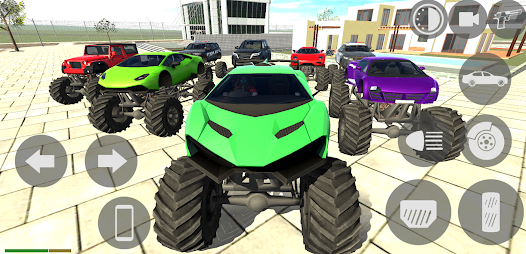Exploring the Thrill of Indian Bikes in 3D

Indian motorcycles have always held a special place in the hearts of enthusiasts around the world. Known for their classic designs, powerful engines, and a rich history that dates back over a century, Indian motorcycles continue to captivate riders and collectors alike. In recent years, the motorcycle industry has seen a significant evolution with the incorporation of cutting-edge technology, including 3D design and engineering. In this article, we delve into the world of Indian bikes driving in 3D, with a particular focus on the H2, H3, and H4 models.
Indian Motorcycles: A Brief History
Before we dive into the 3D realm of Indian bikes, let’s take a moment to appreciate the history of this iconic brand. Founded in 1901, Indian Motorcycle Company was an American motorcycle manufacturer based in Springfield, Massachusetts. The brand quickly gained a reputation for producing high-quality, performance-driven motorcycles.
Throughout its history, India produced legendary motorcycles like the Chief, Scout, and the famous FTR750, which dominated flat-track racing. However, India faced various challenges and ownership changes over the years, leading to its temporary demise in the 1950s.
The Indian brand was revitalized in the 21st century when Polaris Industries acquired it. This acquisition marked a new era for Indian motorcycles, focusing on blending the brand’s storied legacy with modern technology and innovation. The result has been a lineup of bikes that capture the essence of the past while embracing the future.
The Role of 3D Design in Motorcycle Development
In the modern era, 3D design and engineering have become integral to the development of motorcycles. These technologies offer numerous advantages, from enhancing design flexibility to improving manufacturing precision. Here are some key aspects where 3D design plays a crucial role:
- Design Iteration: 3D modeling allows designers to create and refine motorcycle designs more rapidly than traditional methods. This iterative process ensures that every aspect of the bike, from its aesthetics to its aerodynamics, can be optimized for performance and aesthetics.
- Safety and Performance Testing: Before a motorcycle hits the road, it undergoes rigorous testing. 3D simulations enable engineers to conduct virtual tests to evaluate a bike’s safety and performance characteristics. This helps in identifying and rectifying potential issues before physical prototypes are built.
- Manufacturing Precision: 3D design provides manufacturers with precise specifications for every component of the motorcycle. This ensures that each part is manufactured to exacting standards, reducing errors and improving overall quality.
- Customization: 3D modeling allows for a high degree of customization, both in terms of aesthetics and performance. Riders can choose from a wide range of options to personalize their bikes to their preferences.
The Indian H2, H3, and H4: A 3D Revolution
In recent years, Indian Motorcycles introduced the H2, H3, and H4 models, marking a significant step forward in their commitment to combining tradition with innovation. These models showcase the remarkable impact of 3D design and engineering on motorcycle development.
1. Indian
The Indian H2 is a modern cruiser that pays homage to the brand’s heritage while incorporating cutting-edge technology. The H2’s design is a perfect example of how 3D modeling can breathe new life into classic aesthetics. Its flowing lines and sculpted curves are a result of meticulous 3D design, which allowed the design team to achieve the perfect balance between form and function.
Under the hood, the H2 boasts a powerful V-twin engine with state-of-the-art fuel injection and exhaust systems, optimized through 3D simulations. This ensures that the bike not only looks the part but delivers a thrilling and responsive riding experience.
Additionally, 3D design played a crucial role in enhancing rider comfort and ergonomics. The seat, handlebars, and footpeg positions were meticulously adjusted in the virtual space to provide an ideal riding posture, reducing fatigue on long journeys.
2. Indian
The Indian H3 is a modern interpretation of the classic bobber style. With its minimalist design and stripped-down appearance, the H3 exudes an undeniable sense of cool. This bike represents a perfect marriage of old-school aesthetics and 3D engineering precision.
One of the standout features of the H3 is its frame, crafted using advanced materials and optimized through 3D modeling. This not only reduces the bike’s weight but also enhances its structural integrity, resulting in improved handling and safety.
The H3’s powerful engine benefits from 3D simulations to achieve optimal fuel efficiency and emissions control. This is a prime example of how 3D design contributes to both performance and environmental sustainability.
3. Indian
The Indian H4 is the embodiment of innovation in the Indian Motorcycle lineup. As a futuristic electric motorcycle, it showcases the brand’s commitment to staying ahead of the curve. The H4’s design is a visual masterpiece, with every curve and contour meticulously crafted using 3D modeling techniques.
Incorporating 3D design allowed engineers to create an electric powertrain that maximizes efficiency and range. The batteries and electric motor were precisely placed and optimized through virtual testing, resulting in a bike that not only performs exceptionally well but also contributes to a greener future.
Furthermore, the H4 offers riders a range of electronic aids and connectivity features, all seamlessly integrated thanks to 3D design. From touchscreen displays to smartphone connectivity, these features are designed with user experience in mind, making the H4 a true technological marvel.
Conclusion
Indian motorcycles have come a long way since their inception in the early 20th century. The introduction of the H2, H3, and H4 models represents a bold leap into the future while paying homage to the brand’s storied history. The incorporation of 3D design and engineering has played a pivotal role in shaping these remarkable motorcycles.
With the Indian H2, riders can experience the perfect fusion of classic aesthetics and modern technology. The H3, on the other hand, is a testament to the power of 3D modeling in optimizing performance and safety while maintaining a timeless bobber style. Finally, the H4 stands as a beacon of innovation, showcasing how 3D design can push the boundaries of what’s possible in the world of electric motorcycles.
As Indian Motorcycles continues to evolve, one thing remains clear: the brand’s commitment to quality, performance, and innovation is unwavering. With 3D design and engineering as their allies, the future of Indian motorcycles is bound to be as exciting as its illustrious past. Whether you’re a die-hard enthusiast or simply appreciate the beauty of finely crafted machines, Indian bikes in 3D are a sight to behold and an experience to remember
